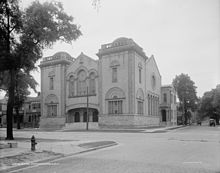The history of Jews in St Louis goes back to at least 1807. St. Louis has the largest Jewish population in Missouri and is the largest urban area in the state of Missouri. Today's Jewish community is primarily composed of the descendants of Jews who immigrated from Germany in the first few decades of the 19th century, as well as Jews who came from Eastern Europe slightly later.

Washington Hebrew Congregation, abbreviated as WHC, is a Reform Jewish synagogue location at 3935 Macomb Street NW, in Washington, D.C., in the United States. Established as a congregation in 1852, the congregation manages two places of worship, the temple in Washington, D.C., completed in 1955, and the Julia Bindeman Suburban Center, a community center, located at 11810 Falls Road, Potomac, Maryland, completed in 1978.

Rodef Shalom Congregation is an historic Reform Jewish congregation and synagogue located at 4905 Fifth Avenue, Pittsburgh, Pennsylvania, in the United States. The landmark building was designed by architect Henry Hornbostel and completed in the Beaux-Arts style.

Congregation Mikveh Israel, is a Sephardic Orthodox Jewish synagogue located at 44 North Fourth Street in Philadelphia, Pennsylvania, in the United States. The congregation traces its history from 1740. Mikveh Israel is a Spanish and Portuguese congregation that follows the rite of the Amsterdam esnoga. It is the oldest synagogue in Philadelphia, and the longest running in the United States.

Congregation B'nai Israel is a Reform Jewish congregation and synagogue located in Galveston, Texas, in the United States. Organized by German Jewish immigrants in 1868, it is the oldest Reform congregation and the second chartered Jewish congregation in the state.

Magnolia Cemetery is a historic city cemetery located in Mobile, Alabama. Filled with many elaborate Victorian-era monuments, it spans more than 100 acres (40 ha). It served as Mobile's primary, and almost exclusive, burial place during the 19th century. It is the final resting place for many of Mobile's 19th- and early 20th-century citizens. The cemetery is roughly bounded by Frye Street to the north, Gayle Street to the east, and Ann Street to the west. Virginia Street originally formed the southern border before the cemetery was expanded and now cuts east–west through the center of the cemetery. Magnolia contains more than 80,000 burials and remains an active, though very limited, burial site today.

Sha'arai Shomayim Cemetery, also known as the Reformed Temple Jewish Cemetery, is a historic Jewish cemetery located in Mobile, Alabama, United States. It was established by Congregation Sha'arai Shomayim in 1876 after their previous cemetery, Jewish Rest in the adjacent Magnolia Cemetery, was filled to capacity. The cemetery is situated on 15 acres (6.1 ha) and is surrounded by a 19th-century cast-iron fence and live oak trees. The entrance is through an ornamental arched gate inscribed with the congregation name in Hebrew letters.

Ahavas Chesed Cemetery, is a historic Jewish cemetery located in Mobile, Alabama. It was established by the Ahavas Chesed congregation in 1898. It covers about 2 acres (0.81 ha) of land in a narrow strip that adjoins the Sha'arai Shomayim Cemetery.
Temple Shalom is a Reform Jewish synagogue located at 23 Bethany Pike, Wheeling, West Virginia, in the United States. The congregation dates from 1849, with the current synagogue building completed in 1957, as the Woodside Temple.
Shaarey Shomayim or Shaarei/ShaarayShamayim/Shomoyim may refer to the following Jewish synagogues:

B'nai Jeshurun is a non-denominational Jewish synagogue located at 257 West 88th Street and 270 West 89th Street, on the Upper West Side of Manhattan, in New York City, New York, United States.

Temple Emanu-El-Beth Sholom, Westmount is a Reform synagogue in Westmount, Quebec. The syngagoue is the oldest Liberal or Reform synagogue in Canada, incorporated on March 30, 1883, and is the only Reform congregation in Quebec.

Temple Anshe Amunim is a Reform Jewish congregation and synagogue located at 26 Broad Street, in Pittsfield, Berkshire County, Massachusetts, in the United States. The congregation was founded by German Jewish immigrants in 1869 as Orthodox, and adopted Reform practice in 1879. It is the second-oldest Reform congregation in the United States and its temple is the oldest synagogue building in Western Massachusetts. In 1904, Anshe Amunim joined the Union of American Hebrew Congregations. It is also affiliated with the Jewish Federation of the Berkshires.

Temple Israel is a Reform Jewish congregation and synagogue, located at 130 Riverside Drive in Dayton, Ohio, in the United States.
Temple Beth Or, founded as Kahl Montgomery, is an historic Reform Jewish congregation and synagogue located at 2246 Narrow Lane Road, in the Cloverdale neighborhood of Montgomery, Alabama, in the United States.
Raphael Benjamin was an English-born rabbi who ministered in Australia and America.
Alfred Geiger Moses (1878–1956) was an American rabbi associated with Reform Judaism and the founder of Jewish Science, a Jewish spiritual movement comparable with the New Thought Movement and viewed as supplementing services at conventional synagogues.
Adolph S. Moses was a German-American rabbi who mainly ministered in Mobile, Alabama and Louisville, Kentucky.














